Drawings are central to the documentation of your designs, whether it is a new product to be manufactured, a new roadway to be constructed, or even the renovation of an existing building.
As designs grow in complexity, so does the need to organize the geometry and annotation in a drawing that is used to generate the output needed to manufacture or build the final product. Based on the types of drawings you create, make sure you understand the following features to help you organize your designs.
Layers
Layers are the primary method for organizing the objects in a drawing by function or purpose. Layers can reduce the visual complexity of a drawing and improve display performance by hiding information that you don’t need to see at the moment.
In this example, the display is limited to the objects on the Floor Plan layer by turning off the other layers.
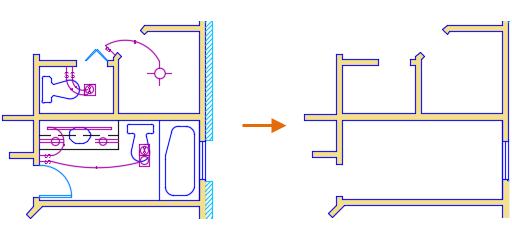
As the number of the layers grow in a drawing, it can take longer to find and change the settings of the layers you need to work with. These advanced layer tools help simplify working with many layers in a drawing:
- Layer filters - Use layer filters to control the number of layers displayed in the Layers drop-down list on the ribbon or the Layers list of the Layer Properties Manager. See Have You Tried: Creating and Applying a Layer Filter for more information.
- Layer states - You can save your current layer settings as a layer state which you can restore later or import to other drawings. A layer state is like a snapshot of the existing layers and layer settings at the time the layer state is created. For more information see, About Managing Layer Settings Using Layer States.
- Layer isolation - Hide the objects on the layers in which you currently are not working with to reduce visual complexity in the drawing. Click here to learn how to isolate selected objects on layers.
For additional information, see:
Layouts
A layout is a 2D working environment for creating drawing sheets.
You can access one or more layouts from the tabs located at the bottom-left corner of the drawing area to the right of the Model tab. You can use multiple layout tabs to display details of the various components of your model at several scales and on different sheet sizes.
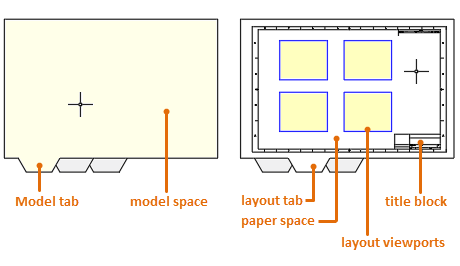
Each layout stores its own page setup which controls the appearance and format for displaying and printing each layout. For example, you would use the page setup to specify the sheet size and orientation.
If you work with many drawings in a single project, it is possible to manage and organize the layouts from those drawings as sheets with the Sheet Set Manager.
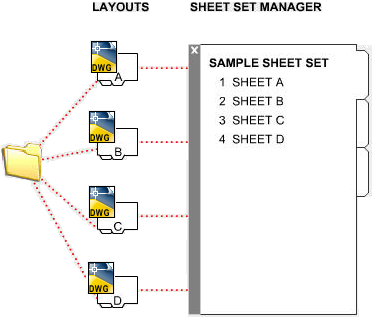
For additional information, see:
Blocks
A block is one or more objects combined to create a single object. The following are some examples of blocks inserted into drawings.
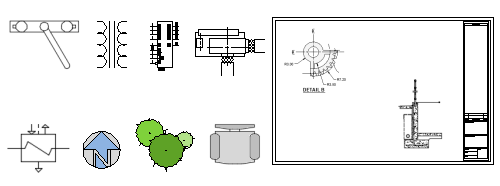
Block definitions can be static or dynamic. The geometry of a static block remains unchanged after it has been inserted, while a dynamic block contains rules and restrictions that control the appearance and behavior of a block when it's inserted into a drawing or later modified. Since the geometry of a dynamic block can be changed, a single dynamic block can be used to represent many static blocks, such as blocks of different door sizes and openings or different types and sizes of fasteners or pipe fittings.
Here is an example of a dynamic block that contains a Visibility state to control the geometry for the swing opening of the door.
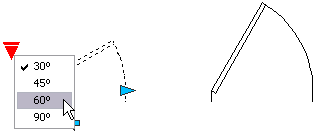
For additional information, see:
Xrefs
You can attach any drawing file as an external reference or xref in the current drawing.
Attached xrefs are links to the model space of a specified drawing file. Changes made to the referenced drawing are automatically reflected in the current drawing when it's opened or if the xref is reloaded. Attached xrefs do not significantly increase the size of your current drawing.
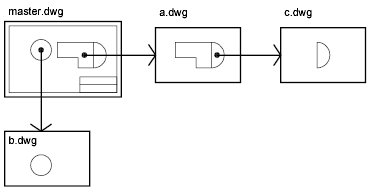
Xrefs can improve the management and sharing of drawings across multiple teams and contractors but as the number of xrefs in a drawing grow, so will the need to manage the paths and settings of those xrefs. These advanced tools will help when working with many xrefs in a drawing:
- Reference Manager - The Reference Manager can be used to identify missing xrefs and resolve path issues without opening each drawing file. See Have You Tried: Manage References Outside AutoCAD for more information.
- Reference Open - You can open an attached xref in a separate drawing window, eliminating the need to open the drawing file manually. Once the drawing has been changed, you can reload the changes in the host drawing. For more information, see About Editing a Referenced Drawing in a Separate Window.
- Reference In-place Edit - Allows you to edit objects in an xref without leaving the current drawing. See About Editing Selected Objects in Referenced Drawings and Blocks for more information.
For additional information, see: